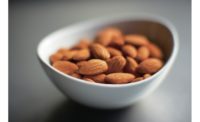New research suggests that there may be more than one reason to add almonds to your daily skin care routine. A new study by researchers at the University of California, Davis[1] found that eating almonds daily in place of typical calorie-matched snacks improved measures of both wrinkle severity and skin pigmentation in postmenopausal women. The study was funded by the Almond Board of California and confirms and expands upon findings in a 2019 study.[2]
In this 6-month randomized controlled trial, 49 healthy postmenopausal women with Fitzpatrick skin type 1 or 2 (characterized by increased tendency to burn with sun exposure) completed the study. Participants were randomly assigned to one of two groups: in the intervention group, women ate almonds as a snack, which accounted for 20 percent of their total daily calorie intake, or 340 calories per day on average (about 2 one-ounce servings). The control group ate a calorie-matched snack that also accounted for 20 percent of calories: a fig bar, granola bar or pretzels. Aside from these snacks, study participants ate their regular diets and did not eat any nuts or nut-containing products.
Skin assessments were made at the start of the study, and again at 8 weeks, 16 weeks and 24 weeks. At each of these visits, facial wrinkles and facial pigment intensity were assessed using high-resolution facial imaging and validated 3-D facial modeling and measurement. Skin hydration, transepidermal water loss (TEWL) and sebum excretion were also assessed.
Researchers found a statistically significant reduction in wrinkle severity in the group consuming almonds: at 16 weeks, there was a reduction of 15 percent and at 24 weeks, a reduction of 16 percent.
There was also a statistically significant decrease in overall facial pigment intensity (unevenness of skin tone) in the almond group: a 20 percent reduction by week 16 that remained so at week 24. Further, body weight remained constant for both the almond group and the control group from baseline to 24 weeks.
“Daily consumption of almonds may be an effective means of improving the appearance of facial wrinkles and skin tone (indicated by decreased pigment intensity) among postmenopausal women with Fitzpatrick skin types I and II. Consumers may describe this reduced pigmentation effect as having a more even skin tone,” according to Dr. Raja Sivamani, dermatologist and lead researcher of this study.
Transepidermal water loss, skin hydration and sebum excretion were measured on the forehead and cheeks in both groups during the study:
- There were no changes in transepidermal water loss at any time point among the almond and control groups.
- At the end of the study, there were increases in skin hydration among both groups.
- Looking at sebum excretion rate, both groups showed an increase on the cheeks, but only those in the control group showed an increase in the forehead area.
“Our findings emphasize the need to look at almonds as a whole food with multiple nutrient components including alpha-tocopherol (vitamin E) and good unsaturated fats, rather than oversimplifying potential benefits due to one nutrient alone. Almonds are high in alpha-tocopherol which has antioxidant functions, and may be partially responsible for the effects that we see in both wrinkles and skin tone in postmenopausal women,” says Dr. Sivamani.
Limitations of the study include its duration of 24 weeks; results do not provide insight into the potential effects of longer-term almond intake. Additionally, the study participants were postmenopausal women with Fitzpatrick skin types I and II (characterized by increased tendency to burn with sun exposure). More research is warranted to investigate the impact of almond consumption in other populations. And, although the snacks in both groups were calorie-matched, they were not macronutrient-matched.
Study at a Glance:
The Study: Healthy, postmenopausal women with Fitzpatrick skin type I (always burns, never tans) or II (usually burns, tans minimally) were randomly assigned to either an intervention or a control group. Almonds were provided as 20 percent of total daily calorie intake for the intervention group (340 calories/day on average), about 2 one-ounce servings. The control group consumed a calorie-matched snack in place of almonds daily: fig bar, energy bar or pretzels. All participants were advised not to consume any nuts or nut-containing products over the course of the study (except for the almond snack for the intervention group). They otherwise were advised to continue their usual daily energy intake. Out of 56 participants who began the trial, 49 women completed it.
Skin assessments were conducted at baseline, 8 weeks, 16 weeks and 24 weeks and participants were weighed at each interval. These assessments included measuring facial wrinkles, skin pigmentation, transepidermal water loss, skin hydration and sebum production. Forty-nine women completed the study.
Results:
- Photographic image analysis showed that the almond group had statistically significant reductions in wrinkle severity, by 15 percent at week 16 and 16 percent at week 24, compared to the control group (P<0.05).
- Average facial pigment intensity was decreased by 20 percent at week 16 in the almond supplementation group and remained so at 20 percent at week 24. There was no improvement in facial pigment intensity in the control group.
- There were no changes in transepidermal water loss at any time point among the almond and control groups.
- At the end of the study, there were increases in skin hydration on the cheek and forehead among both groups, compared to baseline.
- Both groups showed a statistically significant increase in sebum production on the cheeks, but only those in the control group showed a significant increase in the forehead sebum excretion rate, with an increase of 45 percent and 155 percent at weeks 16 and 24, respectively (p<0.05).
- Body weight remained constant for participants in both the almond group and control group from baseline to 24 weeks.
Study Limitations: Since this study was limited to 24 weeks, results do not provide insight into longer duration and effects of eating almonds. Additionally, the study participants were postmenopausal women with sun sensitive skin types Fitzpatrick I and II, so results cannot be generalized to younger, male or higher Fitzpatrick skin type populations. And, although the snacks in both groups were calorie-matched, they were not macronutrient-matched.
Conclusion: Results of this study suggest that daily consumption of almonds could be an effective dietary contributor to improving facial wrinkles and reducing skin pigmentation among postmenopausal women with Fitzpatrick skin types I and II without causing weight gain. Further studies should expand the study population with participants who are younger and have higher Fitzpatrick skin types.
[1] Rybak I, Carrington AE, Dhaliwal S, Hasan A, Wu H, Burney W, Maloh J, Sivamani RK. Prospective Randomized Controlled Trial on the Effects of Almonds on Facial Wrinkles and Pigmentation. Nutrients. 2021; 13(3):785. https://doi.org/10.3390/nu13030785
[2] Sivamani RK. Prospective randomized controlled pilot study on the effects of almond consumption on skin lipids and wrinkles. Phytother Res. 2019 Dec;33(12):3212-3217. doi: 10.1002/ptr.6495. Epub 2019 Oct 1.




